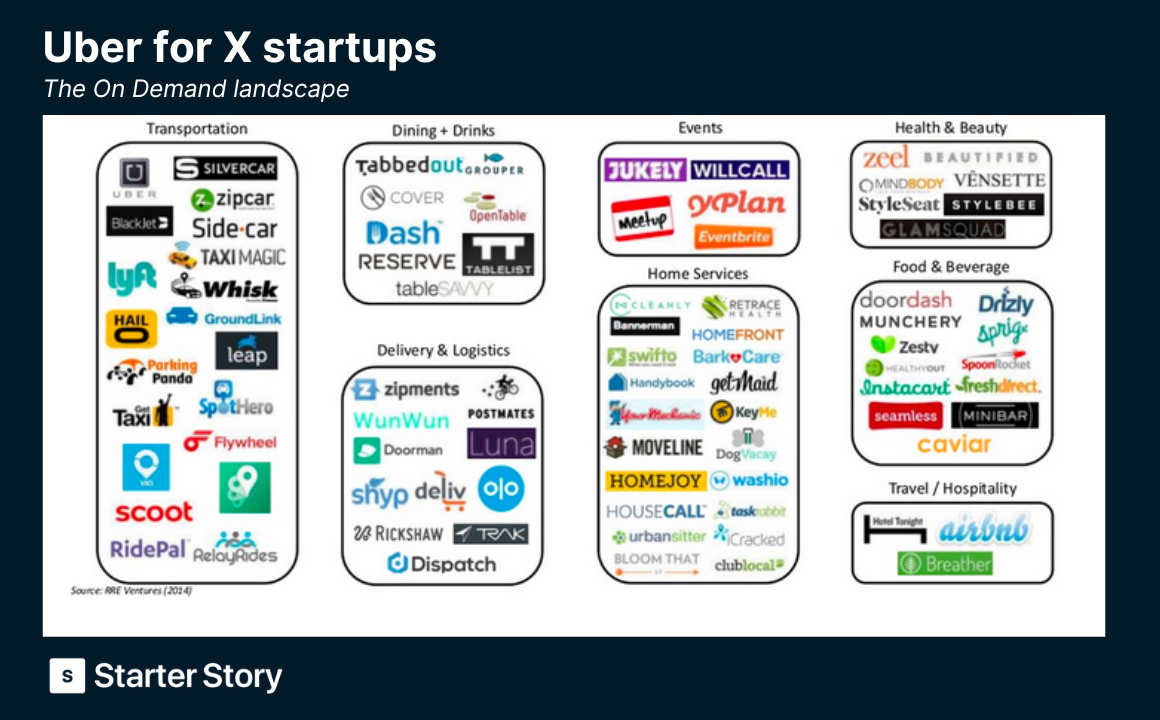Uber for X = $30M/year
This is an archive of the Starter Story newsletter, which is read by 247K people every week.
In each issue, we share the biggest business ideas that are working today, along with case studies of founders who are making millions every month. Sign up today ➜
Uber for X
Following the success of the ride-hailing app Uber ($26.61B turnover in 2020), the model Uber for X became fairly popular, with entrepreneurs trying to replicate Uber’s success in other industries. This trend faded away with time, but that doesn’t mean it isn’t a valid model anymore.

What’s the secret sauce for an Uber for X business to succeed?
#1. Find a space with low technology adoption. For Uber, this was taxis, those yellow cars that you had to chase down the street. But there are other activities where this was also applied successfully, such as grocery shopping (Instacart), and accommodation (Airbnb).
#2. Be able to aggregate demand. This is absolutely key. When building a marketplace, you need to make sure that when users land there, they're going to find a fair amount of choices. Uber had to create its own army of drivers, but aggregating existing suppliers it's an easier route.
A great example that this still can be done: read how this Uber for lawn care makes $30M/year.
Other businesses that replicated the same model with huge success:
Are you familiar with an industry that captures demand in a very traditional way? Do you experience as a user the pain of a very old-fashioned set up to hire a service? That’s a business opportunity right there. Those are situations where the Uber for X model can work perfectly.
Remember that you don’t need to provide the service yourself. Your objective is to create a platform where demand and supply can find each other easily. The challenge is to capture enough from each side.
Together with Semrush
How this website went from side project to 5M visits and $200K/year
They took these 3 key steps:
#1. Ran a Semrush Backlink Audit and removed links from spammy websites.
#2. Low-hanging fruit keyword strategy approach. Targeting relevant low-competition keywords at first; to quickly grow traffic and build site authority, which lets you rank for more competitive keywords.
#3. Content optimization. Achieving an average 2.5X increase in pageviews for articles optimized using Semrush’s SEO Writing Assistant.
>> Try these Semrush tools for FREE during 14 days and start growing your website.
Can’t code? Not an excuse
Years ago, starting an online business without a technical background might have seemed kind of impossible.
That’s not the case anymore.
There’s a myriad of tools that can help you get your business idea off the ground. Even if you have zero knowledge and experience building digital products.
This new no-code app got 400 users in 3 months (because it does something really cool).
The options available for everybody to build, launch and run a million-dollar business with a very simple set of no-code tools just keep growing.
Stop thinking about developing expensive custom solutions, just find an idea and build it. Dream big. These case studies prove that no-code isn't just for simple projects:
Want more examples? Here are 44 business ideas that you can start using no-code tools.
Starter Story Summer Sale
Start a business… in your swimsuit
Summer’s here! A great time for relaxing, going out and lots of doing nothing.
If you’re like me, you’d probably get tired of that pretty quickly.
These are the 3 reasons why you should use all that free time to start a business:
#1. Your potential competitors are not working.
#2. People are more willing to spend money during the summer (facts).
#3. There’s plenty of time to launch something and start making money. This couple reached $10K in sales in just a few weeks (now they’re making over $10M/year).
25% OFF Summer Promo -> Join us today and learn how to start a successful business. Access 3,000+ real-life case studies and copy their winning strategies step-by-step. No BS, no fake gurus. Just the real deal.
Quick hitters
(1) This founder bootstrapped a $300K/year online greeting cards service. Another traditional product that we never thought we’ll see change that mutated to adapt to the Covid era.
Other businesses had to do it too, these starters paid attention and moved quick:
(2) This Amish brand sells $6M/year. Amish are a very secretive community, but some of their talents are very sought after. Their craftsmanship and woodworking skills are two of the top ones.
Now that the whole world has processed the existence of IKEA and the likes, higher-quality alternatives are gaining popularity. Like this $12M/year sustainable furniture company.
--
Thanks for reading!

Download the report and join our email newsletter packed with business ideas and money-making opportunities, backed by real-life case studies.

Download the report and join our email newsletter packed with business ideas and money-making opportunities, backed by real-life case studies.

Download the report and join our email newsletter packed with business ideas and money-making opportunities, backed by real-life case studies.

Download the report and join our email newsletter packed with business ideas and money-making opportunities, backed by real-life case studies.

Download the report and join our email newsletter packed with business ideas and money-making opportunities, backed by real-life case studies.

Download the report and join our email newsletter packed with business ideas and money-making opportunities, backed by real-life case studies.

Download the report and join our email newsletter packed with business ideas and money-making opportunities, backed by real-life case studies.

Download the report and join our email newsletter packed with business ideas and money-making opportunities, backed by real-life case studies.
